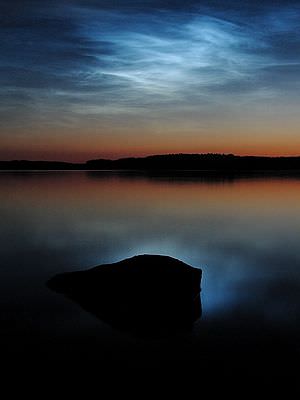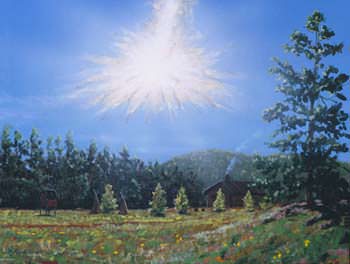[/caption]
The 1908 Tunguska event has always been mysterious and intriguing because no one has been able to fully explain the explosion that leveled 830 square miles of Siberian forest. But the latest research has concluded that the Tunguska explosion was almost certainly caused by a comet entering the Earth’s atmosphere. And how researcher Michael Kelly from Cornell University came to that conclusion is quite interesting: He analyzed the space shuttle’s exhaust plume and noctilucent clouds.
“It’s almost like putting together a 100-year-old murder mystery,” said Kelley, a professor of Engineering, who led the research team. “The evidence is pretty strong that the Earth was hit by a comet in 1908.” Previous speculation had ranged from comets to meteors.
Noctilucent clouds are brilliant, night-visible clouds made of ice particles and only form at very high altitudes and in extremely cold temperatures. These clouds appeared a day after the Tunguska explosion and also appear following a shuttle mission.
The researchers contend that the massive amount of water vapor spewed into the atmosphere by the 1908 comet’s icy nucleus was caught up in swirling eddies with tremendous energy by a process called two-dimensional turbulence, which explains why the noctilucent clouds formed a day later many thousands of miles away.

Noctilucent clouds are the Earth’s highest clouds, forming naturally in the mesosphere at about 55 miles over the polar regions during the summer months when the mesosphere is around minus 180 degrees Fahrenheit (minus 117 degrees Celsius).
The space shuttle exhaust plume, the researchers say, resembled the comet’s action. A single space shuttle flight injects 300 metric tons of water vapor into the Earth’s thermosphere, and the water particles have been found to travel to the Arctic and Antarctic regions, where they form the clouds after settling into the mesosphere.
Kelley and collaborators saw the noctilucent cloud phenomenon days after the space shuttle Endeavour (STS-118) launched on Aug. 8, 2007. Similar cloud formations had been observed following launches in 1997 and 2003.

Following the Tunguska Event, the night skies shone brightly for several days across Europe, particularly Great Britain — more than 3,000 miles away. Kelley said he became intrigued by the historical eyewitness accounts of the aftermath, and concluded that the bright skies must have been the result of noctilucent clouds. The comet would have started to break up at about the same altitude as the release of the exhaust plume from the space shuttle following launch. In both cases, water vapor was injected into the atmosphere.
The scientists have attempted to answer how this water vapor traveled so far without scattering and diffusing, as conventional physics would predict.
“There is a mean transport of this material for tens of thousands of kilometers in a very short time, and there is no model that predicts that,” Kelley said. “It’s totally new and unexpected physics.”
This “new” physics, the researchers contend, is tied up in counter-rotating eddies with extreme energy. Once the water vapor got caught up in these eddies, the water traveled very quickly — close to 300 feet per second.
Scientists have long tried to study the wind structure in these upper regions of the atmosphere, which is difficult to do by such traditional means as sounding rockets, balloon launches and satellites, explained Charlie Seyler, Cornell professor of electrical engineering and paper co-author.
“Our observations show that current understanding of the mesosphere-lower thermosphere region is quite poor,” Seyler said. The thermosphere is the layer of the atmosphere above the mesosphere.
Source: NewsWise


Err… Nancy, in the third paragraph, first line, it should be: Noctilucent clouds are brilliant, night-visible clouds made of ice particles and… 😉
seems to make sense.
My main argument against this theory still is that it seems utterly impossible that tis comet could have been missed until it actually hit our atmosphere. The astronomers of the day were not primitives. A argument that may make more sense is that this was a large burned out cinder of a comet fragment that hit.
We’re not talking about a comet like Halley, which is kilometers wide and has a prominent and very noticeable tail. This was a chunk of ice only a few tens of meters across- so it would have been many, many times fainter.
It also struck at 7:14am, which makes it somewhat more likely to have been coming from roughly the direction of the Sun- making it even harder to spot. And Siberia is a rather sparsely populated place. It would have been a miracle id it had been spotted before it hit, I think.
I reckon the message really is: “We still don’t know”
😉
btw: Tuesday coming is the 101st anniversary of the event.
“the message really is: “We still don’t know””
I would argue the reverse. Whether these researchers theory is found to be correct or not, they have seen four correlations (in observing clouds, cloud height/type, time and distance). Either one of those tests the water content hypothesis – together they are pretty strong IMHO.
I for one hail our cometary (and putative eddy) over-the-head lords.
Torbjorn Larsson OM, I’ve seen many conjectures and notions come and go.
I remember when the “meteorite versus comet” debate was finally resolved, conclusively, in favour of a meteorite.
Somebody showed that a chunk or blob of antimatter (about 100g to 200g) would have been fairly consistent with the damage – alas, they could not describe a convincing scenario for the origin of the antimatter.
A team from Texas suggested a small-ish Black Hole passing right through the Earth – somebody else showed that the damage should have been much greater… and an expected exit event in the North Atlantic could not be traced.
A blob of Plasma ejected from the Sun was suggested and discarded very quickly when I was a young student…. 30 years ago, or thereabouts.
Now, the resurrected Comet has a problem: how could the cometary material disperse so quickly around the globe.
The most convincing idea I’ve seen is actually from a Sci-Fi-ish Suspense and Political Intrigue novel, “Singularity” by Bill deSmedt (spelling?), proposed by a fictional scientist: a primordial black hole. Viral marketing for the book, probably put together by (a) “real” scientist(s), explained it nicely, mathematics and all… but it didn’t supply a mechanism by which such a “tiny” hot black hole could have survived 13.7 billion years of emitting Hawking Radiation….
ah, well….
I thought it was “proven” that an alien spaceship crashed, and exploded. Remember, they found those navigational rocks! 😀
Yes whatever happened to the rocks with the stellar maps? Perhaps this is how a conspiracy cult works; hatch a poorly conceived press release , wait for dodgy media outlet to take bait, then languish in the cover up side story.
I have never seen Noctilucent clouds, do they really glow so much as to illuminate a night??
Would the glow only occur while the Sun is still hitting the high atmosphere, but not necessarily all night?
Damian K
I’ve seen photos taken during the night after the event. Apparently it was possible to read the newspaper outside at midnight, in London.
I fgured this was the direction that this was going. There was an article within the last year I believe speculating that the impact was the result of a comet that bounced off the atmosphere and a piece of it subsequently broke off and caused this explosion. What makes more sense is that it was a comet fragment that had already detatched from it’s parent body long ago that hit the atmosphere, leaving out the part about a larger object glancing off since the larger body would have been detected. As such it may be possible to trace the fragment back to a known parent body based on when it impacted.
“As such it may be possible to trace the fragment back to a known parent body based on when it impacted.”
That’s an idea. Has anyone attempted to do so? Assuming the devastator was indeed a comet fragment.
@Nancy – typo “Cornell University came to that conclusion it quite interesting” … “is quite interesting”
@Greg – if I recall it is suspected of being from comet Encke and the Beta Taurids shower.
I know there is some data on the trajectory from the blast pattern but I have no idea if this has been extrapolated backwards to possible orbits. Still I’d expect a fair bit of wiggle room in any such prediction.
@Feenixx – the comment about an exit wound in the North Atlantic suggests that a trajectory has been predicted.
Hmmm… I always leaned toward shuttle exhaust as a possible vector for Noctulescent cloud formation. This story seems to confirm that.. makes sense anyway…. finally.
Now, a comet entering the upper atmosphere would reach temperatures that might preclude a fusion or fission reaction?
THAT makes sense too in that the fused glass deposits found in Africa and Australia seem to have been created by an air blast with substantial thermal/radiative energy… also cometary chunks? OR even the postulated cometary strike above North America 13,000 BCE explained?
Gee, one Russian scientist comes out with a paper detailing how the blast was caused by a UFO, then suddenly a few short weeks later another paper comes out with an incredibly mundane explanation.
What a coincidence (rolls eyes).
I find the premise of the paper to be a ridiculous assumption. Hmm, what’s all that white stuff in the ground in those Tunguska pictures? Do ya think if a few hundred tons of the stuff got blasted into the air that it wouldn’t have a similar effect?
JIm
And then there’s this little jewel:
“Kelley said he became intrigued by the historical eyewitness accounts of the aftermath, and concluded that the bright skies must have been the result of noctilucent clouds. ”
It’s incredibly vauge as to whether witnesses themselves actually described “noctilucent clouds”, or whether the author of the paper just heard accounts of “bright skies” and ASSUMED they were such clouds.
Even though I do believe other life is visiting Earth, I was initially skeptical of the Russian scientist’s paper about the “Tunguska UFO”. However, this followup “research” came out so quickly afterwards and is based on such a weak assumption that it actually makes me wonder if the initial explanation didn’t have more truth to it than we realized.
JIm